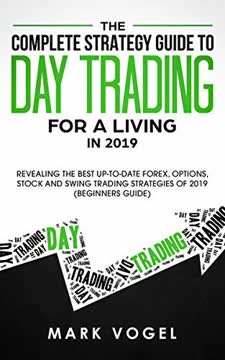Key Takeaways
1. Master the Fundamentals of Day Trading
Day trading is a stock market strategy where a trader buys and sells stocks before the market closes for the day.
Definition and benefits. Day trading involves executing multiple trades within a single day, aiming to profit from short-term price movements. Key benefits include:
- Quick profit realization
- Ability to capitalize on market volatility
- Lower overnight risk exposure
- Potential for higher returns compared to long-term investing
Essential skills and tools. Successful day traders require:
- In-depth market knowledge
- Emotional discipline
- Adequate capital
- Advanced trading software and platforms
- Real-time news sources and data feeds
2. Develop a Disciplined Trading Strategy
Having a strategic plan in place can help you identify your goals and stick with them.
Create a comprehensive plan. A well-defined trading strategy should address:
- Trading goals and objectives
- Specific entry and exit criteria
- Risk management rules
- Time frames for trades
- Markets and instruments to trade
Importance of consistency. Adhering to a disciplined approach helps:
- Minimize emotional decision-making
- Improve trade execution
- Facilitate performance evaluation and improvement
- Increase overall profitability in the long run
3. Understand and Manage Risk in Day Trading
It is important to align your trade with the direction of the market.
Risk management techniques. Implement these strategies to protect your capital:
- Set stop-loss orders for each trade
- Use proper position sizing (e.g., risking no more than 1-2% per trade)
- Diversify across different markets and instruments
- Avoid overleveraging your account
Psychological aspects. Managing emotions is crucial for risk control:
- Recognize and mitigate fear and greed
- Maintain discipline in following your trading plan
- Accept losses as part of the trading process
- Continuously educate yourself on market dynamics
4. Utilize Technical Analysis for Short-Term Trades
Traders should have an idea of how things stand in the S&P 500 with regard to longer periods moving averages including 40-, 30- and 10-week.
Key technical indicators. Day traders commonly use:
- Moving averages
- Relative Strength Index (RSI)
- Stochastic oscillator
- Bollinger Bands
- Volume indicators
Chart patterns and price action. Recognize and trade based on:
- Trend lines and channels
- Support and resistance levels
- Candlestick patterns
- Price action signals (e.g., breakouts, reversals)
Combine multiple indicators and timeframes for more reliable trading signals.
5. Explore Various Day Trading Markets and Instruments
Forex as a Hedge
Diverse trading opportunities. Day traders can participate in various markets:
- Stocks and ETFs
- Forex (foreign exchange)
- Futures contracts
- Options
- Cryptocurrencies
Market characteristics. Each market offers unique advantages:
- Forex: High liquidity and 24-hour trading
- Futures: Leverage and standardized contracts
- Stocks: Familiarity and wide range of choices
- Options: Defined risk and potential for high returns
Choose markets that align with your trading style, risk tolerance, and capital requirements.
6. Implement Automated Trading Systems Wisely
Automated trading systems refer to mechanical trading systems that use algorithms that automatically set off trading based on specific rules regarding the entry and exit points.
Benefits of automation. Algorithmic trading can provide:
- Faster execution of trades
- Removal of emotional decision-making
- Ability to backtest strategies
- Simultaneous monitoring of multiple markets
Potential drawbacks. Be aware of these risks:
- Over-optimization leading to poor live performance
- Technical glitches and system failures
- Lack of flexibility in rapidly changing markets
- Dependence on historical data that may not reflect current conditions
Regularly monitor and adjust automated systems to ensure optimal performance.
7. Differentiate Between Trading and Investing Approaches
Traders usually choose their trading styles based on different factors that can include account size, the time that can be spent trading, the experience level, the risk appetite, etc.
Trading vs. investing. Key differences include:
- Time horizon: Short-term for trading, long-term for investing
- Frequency of transactions: High for trading, low for investing
- Profit strategy: Price movements for trading, growth and dividends for investing
- Risk profile: Generally higher for trading, lower for investing
Choosing your approach. Consider these factors:
- Available time and resources
- Risk tolerance and financial goals
- Market knowledge and experience
- Personal temperament and psychology
You can combine both approaches in your overall financial strategy.
8. Adopt Proven Strategies for Consistent Profits
If you wish to make it big in the world of stocks, then here is a simple guide to follow.
Effective trading strategies. Consider implementing these approaches:
- Trend following: Riding established market trends
- Breakout trading: Capitalizing on price movements beyond key levels
- Reversal trading: Identifying and profiting from trend changes
- Scalping: Making numerous small profits on minor price changes
Continuous improvement. Enhance your trading performance by:
- Keeping a detailed trading journal
- Regularly reviewing and analyzing your trades
- Staying updated on market news and events
- Networking with other traders and learning from their experiences
- Adapting your strategies to changing market conditions
Remember, successful day trading requires dedication, discipline, and ongoing education.
Last updated:
Download PDF
Download EPUB
.epub digital book format is ideal for reading ebooks on phones, tablets, and e-readers.




